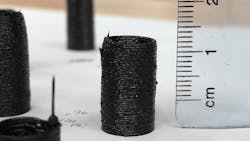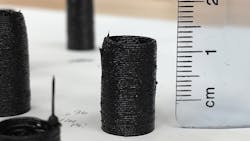X-Rays Used to Explore 3D Printing and Composite Inks
3D printing is not yet mature enough for practical use in the defense industry, based on complications that arise in the way printed layers keep their shape when bonding to each other. Material porosity and other factors such as weak blending can result in poor bonding between layers, weakening the overall structure of the printed part.
One way to address this problem is by adding reinforcement fillers such as fibers, as well as nanofillers, to the composite medium to modify its flow and setting (rheology), and aid in overall structural bonding.
In common terms, the resulting behavior can be compared to that of toothpaste, which flows easily under pressure but doesn’t drip or flow when at rest. The right amount of nanofiller, when added to reinforcing filler such as carbon fiber, greatly improves the mechanical properties of the finished part. Therefore, understanding the material properties and dynamics of different mixtures of composites and nanofillers is an important step in making 3D printing more practical for common use.
To advance the body of knowledge in this topic, researchers at the Air Force Research Lab got an unprecedented view into the behavior of these materials by using the National Synchrotron Light Source II at Brookhaven National Laboratory.
Air Force researchers used the ultra-bright X-ray at Brookhaven National Laboratory’s National Synchrotron Light Source II to gain better insight into composite inks and the bonding of composite layers during the additive manufacturing process. (U.S. Air Force photo/Harry Pierson)
“We were awarded beam time at the X-ray Photon Correlation Spectroscopy (XPCS) beamline, which let us simultaneously look at the dynamics and structure of materials during processing with millisecond time resolution,” says Hilmar Koerner, material scientist and Air Force researcher. His team used their beam time to pass ultra-bright X-rays though layers of deposited material from a 3D printer, gathering real-time information on the alignment and dynamics of the nanofiller.
Koerner explained that when the composite ink exits the 3D-printing nozzle, it goes from a shear-thinned, easily flowable liquid to a gel within just a few seconds. As the nanofiller particles randomize their orientation, they form a network that gives the composite ink self-supporting properties (similar to toothpaste).
The XPCS let researchers understand this fast process in great detail, providing information that will help improve both composite inks and the entire printing process. More specifically, the data will help the Air Force modify its thermosetting resins and post-processing procedures.
Correlating this data with other, simpler characterization methods will provide several other benefits to the team’s research efforts. These include new closed-loop feedback controls for 3D printers, and a way to characterize AFRL-developed materials that experience much higher temperatures during printing.


